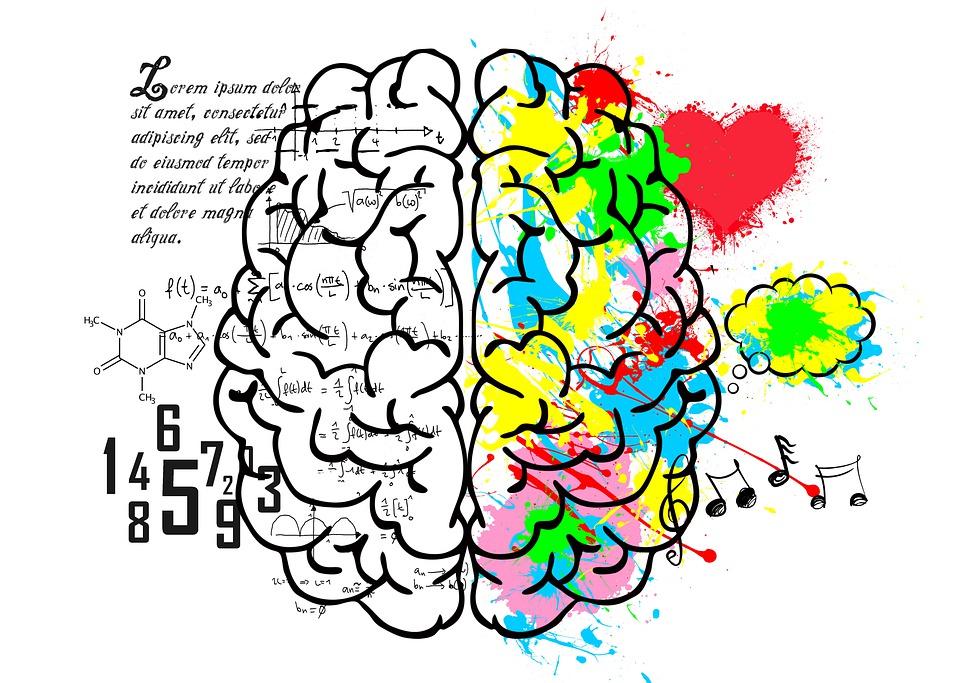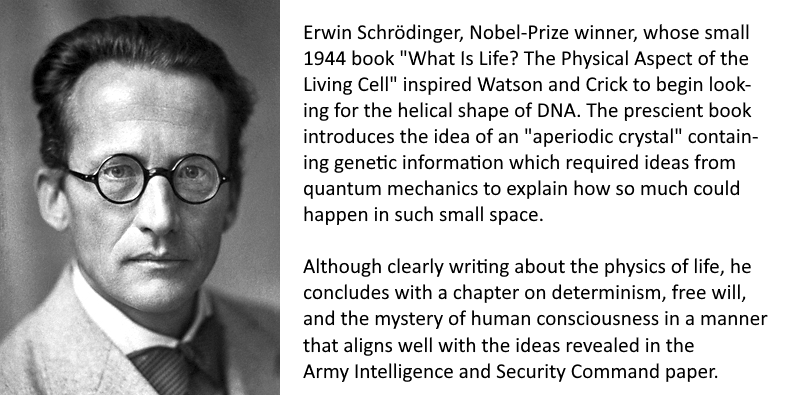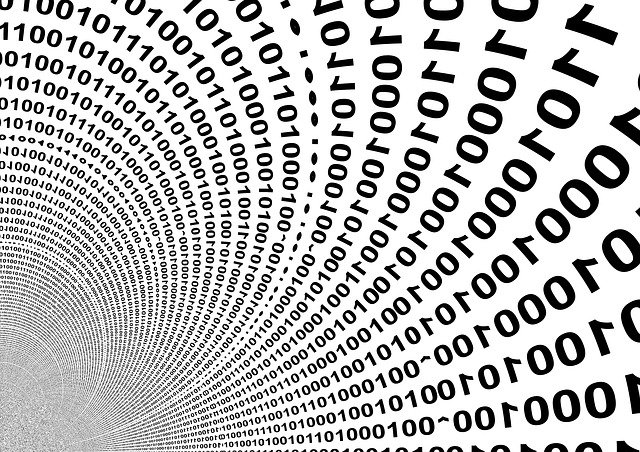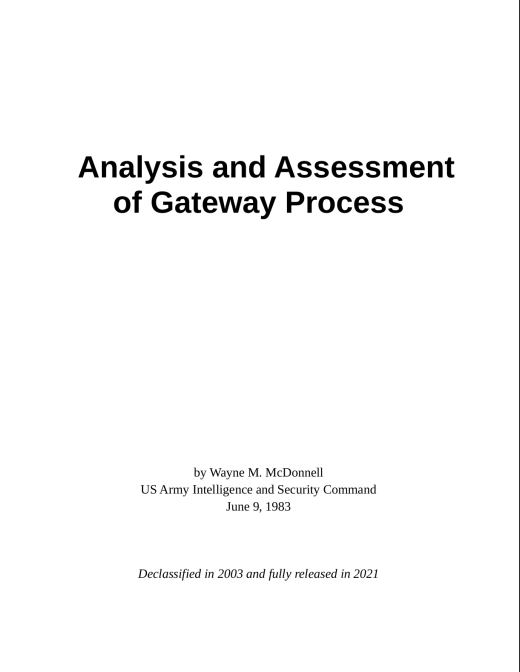Consider the following sentence without any context, except that it was written in 1983: "Then I found it necessary to delve into various sources for information concerning quantum mechanics in order to be able to describe the nature and functioning of human consciousness." Think about it for a moment. Quantum mechanics and human consciousness?
 Now for some context: The person writing this sentence was working within a high level security clearance and had access to some very unusual research at the cutting edge of scientific inquiry -- information which would be hidden from the public review for at least a couple more decades. He is describing, in an introductory cover letter, the remarkable intellectual challenge he experienced during his investigation in order to write about some discoveries involving the mechanics of our two brain hemispheres (see illustration) and the astonishing implications of what happens when they work together properly, instead of being dominated by one side or the other, as is usually the case.
Now for some context: The person writing this sentence was working within a high level security clearance and had access to some very unusual research at the cutting edge of scientific inquiry -- information which would be hidden from the public review for at least a couple more decades. He is describing, in an introductory cover letter, the remarkable intellectual challenge he experienced during his investigation in order to write about some discoveries involving the mechanics of our two brain hemispheres (see illustration) and the astonishing implications of what happens when they work together properly, instead of being dominated by one side or the other, as is usually the case.
In a single sentence, he combines "quantum mechanics" and "the nature and functioning of human consciousness" as if mind and matter were in the same world. If that's not enough, he later goes into astral projection, time travel, super intelligence -- a mixing of ideas we would normally assign to science fiction or woo-ey crackpots who throw together ideas like Jackson Pollack threw together his abstract paintings; flinging paint at a canvas randomly, without structural coherence. However, due to the resources he had available and the target audience, this author is not a crackpot nor a crazy conspiracy theorist.
It was written within the US Army Intelligence and Security Command in the early 1980s. He is serious, and is being taken seriously. One of the reviewers of this paper (after it was declassified) called it "dense," which appears to be a bit of an understatement. It is more dense than it seems because it is so readable.
There is a book's worth of information condensed into this brief 30-page paper. As FOIA and other releases have shown, more like an encylopedia worth of research and information in this area has happened since then, and apparently some of it is still classified. This was not, as the skeptics out there would have you believe, a free-love hippy "Men Staring at Goats" kind of project which can be easily dismissed as a fringe effort by an over-funded War Department which took too much LSD in the 70s and wrote about it in the 80s, but instead, it is the most accessible corner of a significant, yet hidden, series of interconnected research projects, and evidence indicates they are still actively researched and developed to this day.
Taking this seriously
There's a peculiar reason to take the paper seriously, as its intellectual clarity, scientific credibility, level-headed tone, and breadth and depth of material demand. It is the curious matter of a single page missing from its publication in 2003, when it was finally declassified. This single page the Central Intelligence Agency adamantly refuses to publish, even though there were numerous FOIA requests from many parties. In response to such requests, they pretend the page never existed, when it was obvious then, and certain now, that it does. Finally, an obscure research organization (mentioned in the paper) recently revealed that it had a full, unredacted copy of the same paper in its archives, which it had been sitting on for nearly four decades.
Why wouldn't the CIA publish this missing page? And now that we have it, what is on this page that kept them from releasing it for 38 years, intending maybe forever? This is the stuff of which great fiction is written, but this part is all true. On the surface, the missing page is not much different from the other 30. Oh yes, there is already an article by Vice (which first published the missing page earlier this month) describing its contents in appropriately glowing terms. The Vice article is well worth reading; it pulls rich material out of this page, but... to this reader, their description doesn't quite get to the heart of the obvious question: "Why did the CIA feel the need to hide this particular page for four decades?" What is on this page worth hiding?
Before we answer that, think about context for a moment: Wouldn't the fact of hiding a single page lend legitimacy to the whole paper's seemingly-bizarre propositions? Wouldn't this secrecy attract even more attention from fringe conspiracy theorists, and wouldn't some credible people -- who would normally not care -- look more deeply into the matter? We're to assume an intelligence agency understands things like the Streisand Effect well enough to calculate for these inevitable consequences, right? And aren't they required by law to respond to FOIA requests for missing pages that so obviously exist? And is anyone who made these decisions going to get in trouble for breaking the law now? So since they did do all this, there must be something they really don't want people to know, right? Yes, yes, and yes. Nevertheless, even with all that going on, you can see in comments to existing discussions of this paper -- both in its incomplete and its now-complete form -- on numerous websites, people calling it crazy and a waste of time, of no real consequence. Or, in other words, contradicting the importance clearly given by the CIA with a strikingly counter-intuitive: "Don't look here, there's nothing of value, people will call you crazy if you talk about this." So then, let's take the paper seriously simply because the CIA obviously has gone way out on a limb to virtue-signal (vice-signal?) everyone: "This paper is serious." 
In that vein, let's go back and read that introductory sentence from the lede above: "Then I found it necessary to delve into various sources for information concerning quantum mechanics in order to be able to describe the nature and functioning of human consciousness." Now that we made it this far into the conversation: It's not such a strange idea, after all. In fact, Erwin Schrödinger wrote about the interplay between quantum physics and human consciousness clear back in 1944, and his ideas were well known at the time. As witness of that fact, James Watson and Francis Crick took his little book What is Life? as inspiration for their search into the helical structure of DNA (see illustration). And they said so openly. If winning a Nobel Prize is a mark of respectible thinking, and the structure of DNA was predicted accurately ten years before discovery, maybe looking into the quantum mechanics of consciousness isn't as woo-ey as it may sound on the surface. This fact is obscure, but gaining some ground; I discovered it a couple years ago reading an article that came through my social media feed, so I know there are at least a few others out there who know it.
Bringing it out of obscurity
I confess, even though I know that relatively obscure reference (and a few more from writers like Bernardo Kastrup, who has been very rigorously publishing on this topic for the past decade), I'm not equipped to understand all this research paper's ideas. But I recognize that others are. To me, this paper is still a curiousity that goes way over my head. Nevertheless, I do have some desktop-publishing skills, enough to transform the "difficult-to-read" and "missing-pieces" and "blurry-scanned" and "badly cropped" documents available elsewhere into something more presentable. So I did.
I spent an afternoon working on a more readable PDF, and here I'm making it available to all. As far as I know, I'm the first who is publishing a single, easy-to-read, PDF of the whole paper. I'm doing this with the intent that it will fall into the hands of others who will push this document out to still others, who will eventually get it into the hands of people who are equipped to dig in, and together, crowdsourcing this, we can all get to the bottom of this curious matter. But first...
Why is this particular page suppressed?
This is just my personal theory. Feel free to ignore this speculative section and jump to the end where the paper is posted. It appears the page was hidden for possibly multiple reasons, but the one that stands out to me is due to my own peculiar angle of research (obscure, and amateurish, but deserving mention since we're on the subject), and it is possibly the least obvious reason. It is the very clear description, within that missing page 25, of our culture's inherited way of organizing information -- which is very broken. In my little corner of the universe, I call this way of organizing information "binary thinking," or "zero-sum," or "excluded-middle," or "black-and-white," or "linear," or even simply: "categorical," depending on context.
I have developed a particular flavor of dislike for the dominant way of thinking in the world, almost as much as American Indian Russell Means, who once famously put it this way: "For America to live, Europe must die." By "Europe" he means the same thing I mean with "binary thinking." I'm gradually teaching myself to be more ternary-minded, and by this I mean something a little deeper than the average "non-dualist" out there. To the truly ternary mind, "non-dualism" is still a binary way of doing things. The current fad with non-dualism is a step in the right direction, but it's still in the shallow, limited, end of a pool which gets very, very deep.

"Limited" is a good adjective -- actually a neutral one, because it's a technically accurate description of what happens when binary logic limits possible outcomes to exactly two, forbidding all other options by the controversial Law of Excluded Middle. Most people are familiar with this binary property of modern computers, which famously operate using zeros and ones, but very few people are aware that computers can operate with more than two, and that transistors natively can handle far more options, but voltage is used to suppress their functional range to exactly two. Even fewer know that there was a remarkable computer system using ternary logic built in the Soviet Union in the 1960s and 70s, or that computer scientists predict that we'll all be returning to ternary logic in the future because it natively has properties not easily available using binary logic.
That transition is already underway. For example, the limits of binary logic are already causing very real problems in hardware and software. The well-known Iota blockchain was recently designed using ternary logic. There are increasingly more implementations of ternary logic as this new wave of the future arrives, but the fundamental shift is at least a decade away at the current rate.
While it has certain merits, the "limited" binary mindset, when seen from within the larger, more coherent, ternary mindset, is quite simply, a structural impediment to thinking clearly. Over the years I have pieced together a maturing narrative around how this broken method of organizing information developed historically (it goes back to Aristotle), how it evolved over many centuries, and how its dominance has obscured subtle -- but important -- insights in many branches of study. My narrative is made more robust thanks to insights developed by great thinkers like Bernard Riemann, Nikolai Lobachevsky, C. S. Peirce, Jan Lukasiewicz, Alfred Korzybski, Viktor Frankl, Donald Knuth, René Girard, Robert Pirsig, D. G. Leahy, and others.
The binary approach to knowledge obscures deep truths in ways nobody sees because nobody ever looks at the logic of their own thinking enough. If they did, they would realize that the foundation is not laid upon solid ground with pillars going to bedrock, as it seems. It's remarkably difficult to come to this realization because binary logic is embedded in language, and it's really hard to objectively see things which are embedded in your ability to frame what you see. For example, it's only a recent development in mathematics -- within the past century -- to find how deeply logic penetrates to the foundations of everything mathematical. But this was true all along. Likewise, the revolution that came with looking outside Euclidean geometry enabled Einstein's great discoveries within a few decades.
So from that peculiar birds-eye view on things, when I saw the following passage on the missing page 25 (linked to me via social media a few days ago), I recognized its importance immediately, and was delighted. Here is the passage, surprisingly innocuous at first:
35. Left Brain Limitations
Twentieth Century physics would seem to be revisiting insights belonging to mankind as far back as written records can take us: The only difference is that Twentieth Century physics is using a left brain, linear, quantitative style of reasoning to approach the same knowledge which the mystics of old apparently acquired in a holistic, intuitional, right brain style. As a tool in the hands of our left brain culture, Gateway would seem to be a promising method for achieving the intuitive, holistic type of interface with the universal hologram needed to provide the context that thinkers like Einstein have sought in their labors to discover a unified field theory in physics. For persons in our profession whose concerns revolve around strategic issues, tactical questions and matters of managerial form and system, access to a new world of intuitive perception and self reflection would seem to offer, in the long term, the means by which to know in a truly objective way. This is so because the self-imposed limitations to balanced perception and objective logic which our cultural and personal psychological subjectivity imposes when we use the strictly left brain thinking style could be offset by the holistic form of perception associated with altered states of consciousness. To the extent that we come to perceive ourselves fully in the context of that portion of the universal hologram which is the reflection of ourselves, to that extent we release ourselves from the prison of subjectivity.
Most people reading that paragraph will not catch the depth of what is being said. Yes, yes, we all know this left-brain right-brain stuff, right, nothing new here, right? Well, sorta. Did you see that it's saying we're all in a prison of subjectivity? Take that more seriously. Did you catch what I implied earlier by my reference to Alfred Korzybski, whose large masterpiece Science and Sanity also talks about a prison of subjectivity and how to become sane in an insane world? (His book is huge and was well-respected years ago but sadly it is not as well-known as it used to be, even though the key answers he points toward are quite simple, can be described in a few paragraphs, and revolutionize the art of communication in extraordinary ways.)
Knowing these things, I saw it immediately: Although the other sections are over my head, Section 35 of the hidden-for-38-years-page of this bizarre, rambling, possibly-crackpot, easily-ignored document overlaps neatly with my own theories. In fact, I have written similar paragraphs. Knowing how difficult it was for me to learn these things on my own leads me to wonder whether that the whole page was being suppressed because of this otherwise bland-looking paragraph.
I know, I know, I'm going too far: there are other, more striking references on this same page, for example, speaking of the Trinity and the Christian Holy Spirit and the Absolute and God and the merger of eastern and western religions -- these make a pretty big fish, well worth hiding, too; at least in some circles. But... most of these terms are referenced on other pages, some of them directly, others at least hinted at.
Section 35 stands alone, its point is not made elsewhere within the other 30 pages. Thus I think it's a big fish. You see, I've been searching for years for fragments like this, and I know how elusive they can be, and how the various fragments laying around are often not as deep as they seem. This one is deep. So, here is what I see: 1. Your mind is in a linear, quantitative prison, and 2. You can liberate it by studying and understanding what is being revealed in this 30-page paper. Take it seriously, instead of dismissing it as some would have you do. There's an implied point #3 here, but I'll leave it to your imagination to pull it out. Okay, I've said enough. I have a feeling that with the Vice article published earlier this month, the cat's out of the bag, making my speculative contribution here small, in comparison to where others are going with this material.
For those who came here for the PDF, here it is
The content of this PDF is already public domain and fair-use information, so feel free to spread it further, post it on your own blogs and write your own articles with better discussions than this one, if you will, and do NOT give me credit, please. Just pass it along. I've intentionally eliminated metadata in the PDF so that it can be distributed freely by anyone as if it were theirs. If you're grateful, you should know: The hard work of transcribing was done by the author of the Medium article, and the hard work of investigative journalism by the Vice articles (there are two articles, only the latest one is linked here). Give those guys credit, they deserve it. I'm just a guy who made a readable PDF out of existing material. With no further ado, here's the PDF, have at it:

